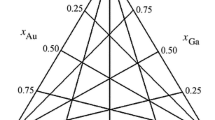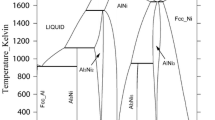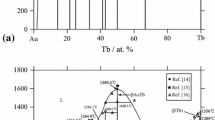Abstract
The results of comparative thermodynamic analysis of AuIn–Sb section in ternary Au–In–Sb system are presented in this paper. Investigation was carried out experimentally, using Oelsen calorimetry at the temperature 873 K and analytically, applying different predicting methods––Toop and Muggianu in the temperature interval from 873 K to 1673 K. The values for integral molar Gibbs excess energies and antimony activities have been determined and compared at temperature of 873 K, which indicated to good agreement between experimental results and results obtained using Toop predicting model.
Similar content being viewed by others
Explore related subjects
Discover the latest articles, news and stories from top researchers in related subjects.Avoid common mistakes on your manuscript.
Introduction
Gold and gold alloys are widely applied in modern technical branches––electronics, communications, space and aero technologies, chemistry and medical science, etc. They are known for good mechanical and thermal properties, as well as corrosion consistency. Owing to the formation of low temperature eutectic, gold alloys are often used as welding alloys in electronics [1].
Indium-based lead-free solder alloys are concerned as a possible alternative to conventional Pb-bearing solders in step soldering, which are required for high density packaging of multi-chip modules demanding a number of solders with melting points over a wide temperature range [2, 3].
Among described systems, the Au–In–Sb alloys have been taken into consideration as the potential lead-free soldering material based on indium and gold, as well. Therefore, knowledge of thermodynamic behavior and phase diagram of ternary Au–In–Sb system is of importance in predicting the interface reactions between In-based solders and Au-substrate, providing a tool for design a potential interface [3]. Thermodynamic data for constitutive binary systems Au–In, In–Sb and Au–Sb can be found in the COST 531 Database for Lead Free Solders [4]. Considering the references on ternary Au–In–Sb system, it was investigated by Kubiak and Schubert [5], Tsai and Williams [6], assessed by Liu et al. [3] and recently examined by Gomidželović et al. [7, 8].
As a contribution to better knowledge of thermodynamic properties of Au–In–Sb system, which is shown in Fig. 1, is the comparative analysis between experimental, calorimetric results and calculated results have been done for the section AuIn–Sb in ternary Au–In–Sb system.
Experimental
The Oelsen calorimetry method, described in Refs. [9–11], was used for the experimental thermodynamic analysis of a section in the ternary Au–In–Sb system with a constant molar ratio of Au:In = 1:1. That method has already shown good results in the investigation of different ternary metallic systems, and also some antimony-based ternary system [12–14].
According to the requirements of the utilized method, the total volume of all samples was constant––0.5 cm3, while their compositions and masses are given in Table 1.
Used metals were of the analytical grade. The water equivalent for the calorimeter was determined by a standard method using dissolved Na2CO3 and its value was 3354 J/K. All experiments were carried out in air atmosphere. The samples were cooled in the furnace to the room temperature. Schematic representation of the used Oelsen calorimeter is given in Fig. 2. The calorimeter is composed of a Dewar flack with water, a stirrer and a thermometer. It also contains housing from copper sheet into which the iron holder with the sample is added, after being heated in a separate oven to the initial temperature. The temperature of the sample is followed with NiCr–Ni thermocouple during cooling and simultaneously the temperature of the water is measured. The pair of values of a temperature measurement in the sample and in the water leads to a point on heat content curve.
Results and discussion
The calorimetric measurements and thermodynamic calculations were carried out in the AuIn–Sb section of the ternary Au–In–Sb system (Fig. 1).
Based on the cooling curves obtained by calorimetric measurements, according to the Oelsen procedure [9–11], temperature changes of the calorimeter were determined for all samples in the temperature range up to 873 K. According to this data, the enthalpy space diagram and enthalpy isotherm diagram were constructed and presented in Figs. 3 and 4, respectively. (It should be noted that in presented diagrams 1 K corresponds to the value of water equivalent).
The basic equation in Oelsen thermodynamic analysis [9] is given as:
where \( G_{i}^{M} \) is i, T 0 the starting temperature, T the final temperature, H x,T the enthalpy value measured in the Oelsen calorimeter for the temperature change from T 0 to T, R the gas constant and a i is the activity of the component i. Further calculation in the thermodynamic analysis was done based on Eq. 1 and the results of the graphic planimetry [7], which enabled the determination of antimony activities, activity coefficients and partial molar quantities at 873 K. The results are given in Table 2.
Slight negative deviation from ideal behavior for antimony activities can be noticed in whole concentration area. Negative values for partial molar Gibbs energies of mixing and partial molar excess Gibbs energies are obtained for all investigated alloys.
In order to confirm that fact, the energetics of mixing in the liquid alloys has been analyzed through the study of concentration fluctuation in the long-wavelength limit, S cc(0), connected with the microscopic information on liquid alloys [15]. The presence of chemical order is indicated by S cc(0) < S cc(0,id), while on the contrary, if S cc(0) > S cc(0,id), the segregation and demixing in liquid alloys takes plase. Using the experimental values for antimony activity presented in this work, S cc(0) at 873 K was calculated using following equation:
and mixing behaviour of liquid alloys in the AuIn–Sb system can be deduced from the deviation of S cc(0) from S cc(0,id), as shown in Fig. 5.
The calculated values of S cc(0) are almost ideal for the concentration interval x Sb = 0-0,4, while for concentrations in the range x Sb = 0,4-1, it can be noticed that S cc(0) < S cc(0,id), which indicates to slight negative deviation from ideal behaviour.
Beside the experimental investigation, two different thermodynamic predicting models, Toop [16] as symmetric and Muggianu et al. [17] as asymmetric, were used for the determination of partial and integral thermodynamic properties in AuIn–Sb system. The basic theoretical interpretations of mentioned models are given as follows:
-
(a)
Toop model [16]
-
(b)
Muggianu et al. model [17]
In all given equations, ΔG E and ΔG E ij correspond to the integral molar excess Gibbs energies for ternary and binary systems, respectively, while x 1, x 2, x 3 correspond to the mole fraction of components in investigated ternary system.
Basic thermodynamic data on the constituent binary subsystems Au–In, In–Sb, Sb–Au, needed for predicting of thermodynamic properties in the investigated AuIn–Sb system, were taken from Cost 531 Database [4] and Ref. [3]. Characteristic Redlich–Kister parameters for constitutive binary systems are presented in Table 3.
According to Eqs. 3 and 4, and based on starting data given in Table 3, integral molar Gibbs excess energies have been calculated for the AuIn–Sb section in the temperature interval from 873 K to 1,673 K. The partial thermodynamic quantities for antimony were derived using well known expressions:
and
Obtained results of calculation according to Toop and Muggianu predicting methods, including ΔG E and a Sb, are shown in Figs. 6 and 7, respectively.
The comparison has been done between the experimental and calculated results at 873 K, which is presented in Fig. 8.
It can be noticed that the agreement between experimental thermodynamic data on antimony activities, obtained by Oelsen calorimetry and calculated by Toop model, is much better comparing to Muggianu model, which indicates to the asymmetric behavior of Au–In–Sb alloys in the investigated section AuIn–Sb. Therefore, it is expectable to obtain more accurate thermodynamic results by application of Toop model in the case of mentioned system.
Conclusions
Comparative thermodynamic analysis of AuIn–Sb system was done experimentally using Oelsen calorimetry and by thermodynamic predicting using models of Toop and Muggianu. Results of the comparative analysis for obtained thermodynamic parameters showed slight negative deviation from Raoult’s law in the whole concentration range and fair agreement between experiments and calculation, especially in the case of Toop method application. Finally, the presented thermodynamic data for the Au–In–Sb alloys, compensating a lack of information for these alloys, could be useful for the further assessment of this system, its phase diagram determination and interpretation of the phenomena occurring in multicomponent lead-free system based on indium [18–21].
References
Živković D, Živković Ž, Manasijević D. Comparative thermodynamic analysis of the Pb-Au0.7Sn0.3 section in the Pb-Au-Sn ternary system. Thermochimica Acta. 2005;435:113–7.
Hwang JS. Environment-friendly electronics: lead-free technology. Port Erin: Electrochemical Publications Ltd; 2001. p. 97.
Liu HS, Liu CL, Wang C, Jin ZP, Ishida K. Thermodynamic modeling of the Au-In-Sb ternary system. J Electron Mater. 2003;32:81–7.
Version 1.1 of the COST 531 Database for Lead-Free Solders (http://www.ap.univie.ac.at/users/www.cost531).
Kubiak R, Schubert K. On the alloy system Au-In-Sb. Z Metallkd. 1980;71:635–7.
Tsai CT, Williams RS. Solid phase equilibria in the Au-Ga-As, Au-Ga-Sb, Au-In-As and Au-In-Sb ternaries. J Mater Res. 1986;1:352–60.
Gomidželović L, Živković D, Mihajlović I. Predicting of thermodynamic properties of ternary Au-In-Sb system. Arch Hutnictwa. 2006;51(3):355–63.
Gomidželović L, Živković D, Talijan N, Manasijević D, Ćosović V, Grujić A. Phase equilibria investigation and characterization of the Au-In-Sb system. J Optoelectronics Adv Mater. 2008;10(2):455–60.
Oelsen W, Tebbe W, Oelsen O. Zur thermodynamischen Analyse VII – Das Trockneis-Kalorimeter. Arch Eisenhuttenwess. 1956;27:689–94.
Oelsen W, Schurmann E, Weigt HJ, Oelsen O. Zur thermodynamischen Analyse IV – Vermischungsentropie und Bildungsaffinitat der Blei-Kadmium-Schmelzen aus kalorimetrischen Messungen. Arch Eisenhuttenwess. 1956;27:487–511.
Oelsen W, Bieret F, Schwabe G. Zur thermodynamischen Analyse VI – Kalorimetrie und Thermodynamic der Wismut-Kadmium-Legierungen. Arch Eisenhuttenwess. 1956;27:607–20.
Živković D, Katayama I, Kostov A, Živković Ž. Comparative thermodynamic study of GaSb-Sn system. J Therm Anal Calorim. 2003;71:567–82.
Kostov A, Živković D, Živković Ž. Comparative thermodynamic analysis of Ga-GeSb0.855 section in the ternary system Ga-Ge-Sb. J Therm Anal Calorim. 2000;60:473–87.
Kostov A, Živković D, Živković Ž. Thermodynamic analysis and characterization of Ga-GeSb0.855 section in Ga-Ge-Sb ternary system. J Therm Anal Calorim. 2001;65:955–64.
Singh RN. Short-range order and concentration fluctuations in binary molten alloys. Can J Phys. 1987;65:309–25.
Toop GW. Predicting ternary activities using binary data. Trans Met Soc AIME. 1965;233:850–5.
Muggianu YM, Gambino M, Bross JP. Enthalpies of formation of liquid alloys. J Chimie Physique. 1975;72:83–8.
Amore S, Delsante S, Parodi N, Borzone G. Calorimetric investigation of the Cu-Sn-Bi lead-free solder system. J Therm Anal Calorim. 2008;92(1):227–32.
Živković D, Milosavljević A, Mitovski A, Marjanović B. Comparative thermodynamic study and characterization of ternary Ag-In-Sb alloys. J Therm Anal Calorim. 2007;89(1):137–42.
Ipser H. Basic research on lead-free soldering. J Min Metall Sec B: Metall. 2007;43B(2):109–12.
Jendrzejczyk-Handzlik D, Živković D, Gierlotka W, Manasijević D, Fitzner K, Minić D. Phase relations near ternary eutectic point in the Ag-In-Sb system. J Min Metall Sec B: Metall. 2007;43B(2):161–9.
Acknowledgements
The authors are grateful to the Ministry of Science and Environmental Protection of the Republic of Serbia (Project No. 142043) for financial support.
Author information
Authors and Affiliations
Corresponding author
Rights and permissions
About this article
Cite this article
Gomidželović, L., Živković, D. Thermodynamic analysis of AuIn–Sb system using Oelsen calorimetry and predicting methods. J Therm Anal Calorim 98, 743–748 (2009). https://doi.org/10.1007/s10973-009-0212-3
Received:
Revised:
Accepted:
Published:
Issue Date:
DOI: https://doi.org/10.1007/s10973-009-0212-3












